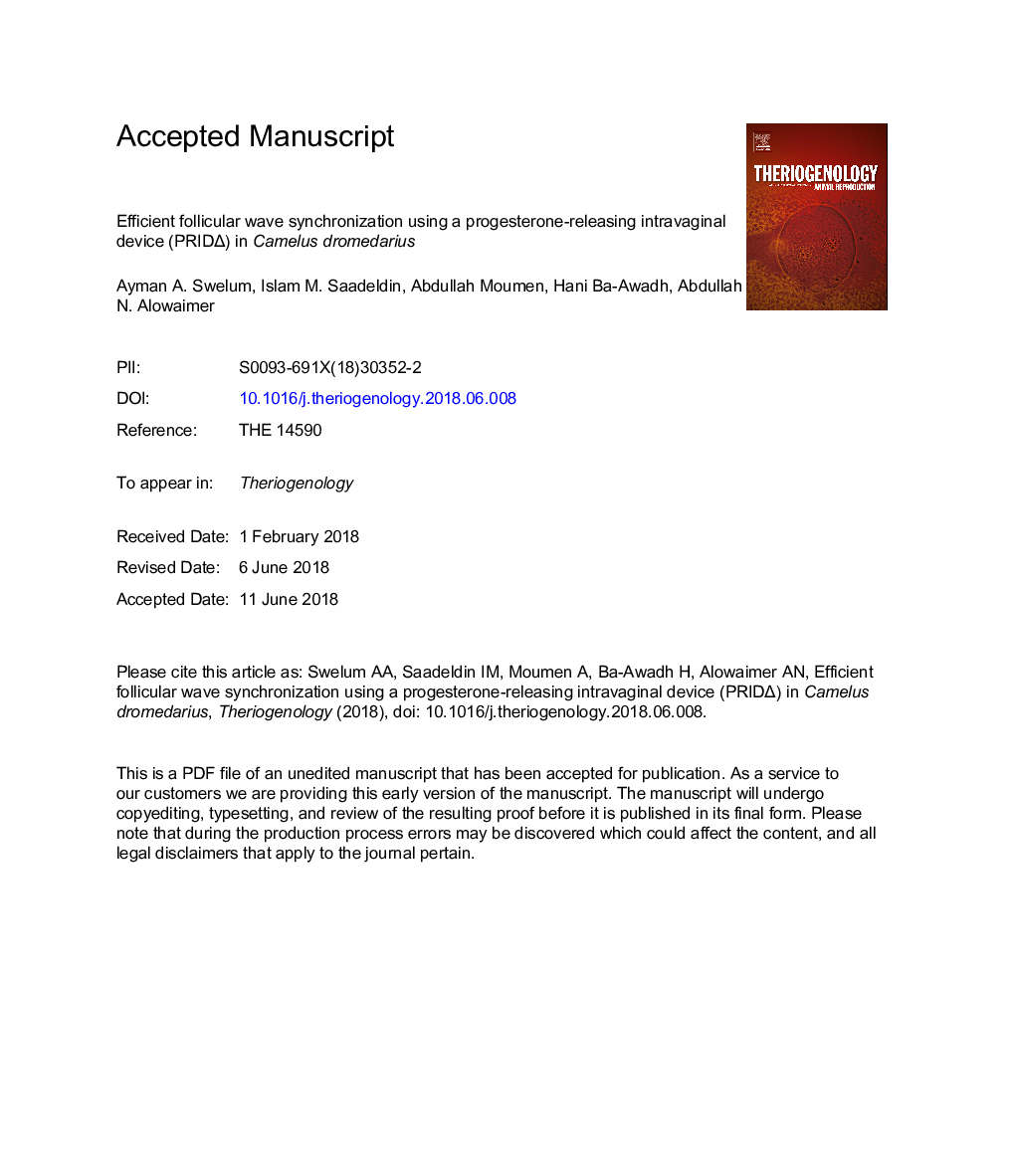| کد مقاله | کد نشریه | سال انتشار | مقاله انگلیسی | نسخه تمام متن |
|---|---|---|---|---|
| 8426463 | 1546051 | 2018 | 33 صفحه PDF | دانلود رایگان |
عنوان انگلیسی مقاله ISI
Efficient follicular wave synchronization using a progesterone-releasing intravaginal device (PRIDÎ) in Camelus dromedarius
دانلود مقاله + سفارش ترجمه
دانلود مقاله ISI انگلیسی
رایگان برای ایرانیان
کلمات کلیدی
موضوعات مرتبط
علوم زیستی و بیوفناوری
علوم کشاورزی و بیولوژیک
علوم دامی و جانورشناسی
پیش نمایش صفحه اول مقاله

چکیده انگلیسی
The reproductive efficiency of camels can be improved using artificial insemination and embryo transfer programs that require a dependable method for synchronization of follicular waves. This study aimed to evaluate the efficacy of a progesterone-releasing intravaginal device (PRIDή) to induce synchronization for the follicular wave in Camelus dromedarius during the rutting season, by ovarian monitoring, assessing sexual receptivity and fertility, and quantifying progesterone (P4) and estradiol (E2) concentrations. Twenty animals received a new PRIDÎ with 1.55â¯g of P4 for 2â¯wk (Day 14); another 20 camels were used as the control. Ultrasound ovarian monitoring and camel sexual receptivity were evaluated each day during the course of the experiment for all camels in the two groups. The proportion of animals in the ovulatory (follicle diameter: 12 to 18â¯mm) and non-ovulatory phases was calculated according to the ovarian monitoring results using ultrasound. Blind natural mating occurred on Day 16, and ovulation, non-return, and fertility rates were calculated. Blood samples were collected. Serum P4 and E2 levels were measured daily during the trial period (21â¯d) using ELISA kits. The results revealed that the proportion of females in the ovulatory phase on Day 16 in the PRIDÎ group was significantly higher than that in the control group (85 and 50, respectively). Serum P4 levels increased significantly after PRIDÎ insertion and reached the maximum values (5.47, 5.02, 5.55, and 4.88â¯ng/mL) on Days 4, 5, 6, and 7, respectively. P4 levels significantly decreased after PRIDÎ removal and reached the minimal levels (1.23 and 0.67â¯ng/mL) on Days 15 and 16, respectively. There was no significant difference in the E2 levels between the groups. Ovulation, non-return, and fertility rates in inseminated camels were significantly higher in the PRIDÎ group (85%, 80%, and 75%, respectively) than in the control group (50%, 45%. and 45%, respectively). In the control group, the P4 level was maintained at a minimal level (â¥1â¯ng/mL). In conclusion, the treatment of dromedary camels with PRIDÎ led to a uniform increase in serum concentrations of P4; however, it could not stop follicular growth. After PRIDÎ removal, P4 concentrations dropped and stimulated the development of a new follicular wave; most female camels were in the ovulatory phase 2â¯d after PRIDÎ removal. Therefore, PRIDÎ is efficient at inducing follicular wave synchronization in C. dromedarius with good fertility.
ناشر
Database: Elsevier - ScienceDirect (ساینس دایرکت)
Journal: Theriogenology - Volume 118, 15 September 2018, Pages 203-211
Journal: Theriogenology - Volume 118, 15 September 2018, Pages 203-211
نویسندگان
Ayman Abdel-Aziz Swelum, Islam M. Saadeldin, Abdullah Moumen, Hani Ba-Awadh, Abdullah N. Alowaimer,